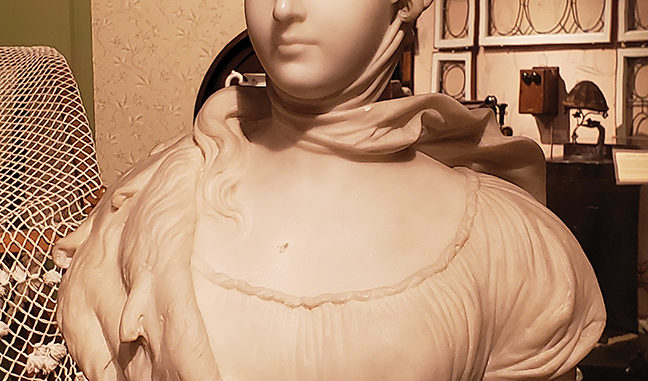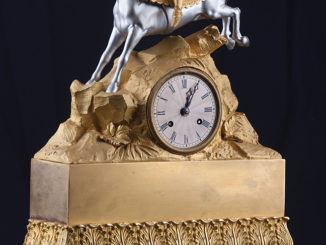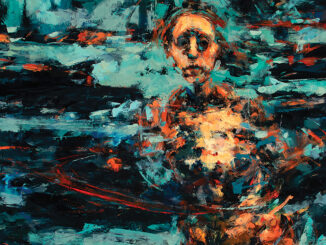
Who is she?
Every time I walked by our bust and chamber set of “Wilhelmina Hohenzoleren,” I asked myself this question. Finally, late last year, I decided it was time to find out.
The clues:
-The chamber set is German, circa 1875.
-The bust features a similar image, was made circa 1875 and states that Wilhelmina lived from 1785 to 1838 and was married to King Wilhelm of the Netherlands.
Unfortunately, if you know anything about monarchies, it’s that usually the men are named after one another. There’s a lot of Wilhelm’s in the Netherlands’ history, so it was time to do some historical detective work. Searching for “Wilhelmina Hohenzoleren,” I kept being directed to “Wilhelmine of Prussia, Queen of the Netherlands.” This fits with our label, but didn’t specifically state “Hohenzoleren” – thus begging the question, why the last name?
Turns out Hohenzoleren was a House name, i.e., the name of a specific dynasty. It belonged to what we now call Germany (and, if you know your history, the region we know as Germany was called various names since its first formation as the Holy Roman Empire in 962 CE, and only became “Germany” in the 1870s). The Hohenzoleren – formally spelled Hohenzollern – family was first mentioned in 1061 CE when they rose to power near Hechingen and established their seat of power at Hohenzollern Castle.

So, we’ve got the family. What about Wilhelmina? Using her assumed birth (1785) and death (1838) dates, we can estimate that her father was likely born between the 1740s and 1760s (since he probably began having children in his late 20s to early 30s, and continued doing so for several years, as nobles are inclined to do). Since our search revealed Wilhelmine of Prussia, I started there. Turns out, Wilhelmine of Prussia was born to King Frederick Wilhelm II of Prussia. Frederick was born in 1744 – making him on target as our Wilhelmina’s father.
However, we don’t always go with first assumptions. To be sure that this was the only possible Wilhelmina, I double-checked other branches of the Hohenzollern family tree, which had split into two main branches by the late 1700s (the Brandenburg-Prussian and the Swabian). In a rare stroke of luck, none of the Swabian side named their daughters “Wilhelmina” or any of its variations, and there was no other Brandenburg-Prussian Wilhelmina who fit.
So, with a little digging, we can safely assume that our Wilhelmina Hohenzoleren is Wilhelmine of Prussia, Queen of the Netherlands. She was born Princess of Prussia on November 18, 1774 – making her 11 years younger than we thought – and very little seems to be known about her. In 1791, at the age of 17, she married her cousin, William of the Netherlands, as part of an alliance between the House of Orange and Prussia. Some sources say the marriage was also a love match, and that the couple led a happy life at their home in Noordeinde Palace, The Hague. Between 1792 and 1810, the couple had six children (only three reached adulthood).
In 1795, the French (led by Napoleon) invaded and forced the family into exile. Over the next ten years, the family became refugees in England, Berlin, and finally Poland. Family legend maintains that despite hardship, Frederick and Wilhelmine were devoted to one another and that Frederick often sought Wilhelmine’s advice. In 1814, they finally returned to The Hague and were crowned king and queen. Wilhelmine was a modest queen, often in ill health, but she loved the arts – especially painting and museum exhibitions. She even practiced art herself, ultimately being inducted as an honorary member of the Royal Academy of Fine Arts. That is likely why art was created of her – probably by the artists she supported, especially after her death in 1837 at the age of 62.
This article sponsored by the Kentucky Department of Tourism.
-by Tiffany Isselhardt
About the Author: Tiffany Isselhardt is the Development and Marketing Manager for the Kentucky Museum, where she uses her knowledge of museums and community collaboration to foster greater opportunities for engagement and increase the Museum’s financial resources. With a Master’s in Public History, she also curates exhibitions and continues researching and publishing on female representation in museums.





